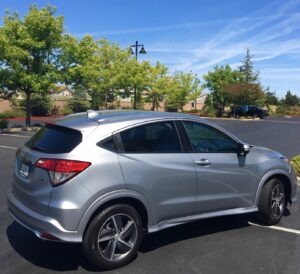Honda was thinking small but acting big when introducing its new subcompact crossover sport utility vehicle several years ago.
The subcompact SUV class was a relatively new endeavor and the Japanese automaker was happy to report the Honda HR-V found a niche right away. Sales of the HR-V were 33,064 in 2016 and the numbers are still good for the somewhat diminutive SUV that has a starting price of under $21,000.

There is only one engine choice with the front-wheel drive 2019 Honda HR-V – a 1.8-liter, four-cylinder that generates 141 horsepower and 127 pound-feet of torque.
The HR-V has experienced no significant changes until this year. The 2019 Honda HR-V has a sizable “what’s new” list, adding refreshed rear and front-end styling; a center screen system; two more trim models (Sport, Touring); a first-time offer of standard Apple CarPlay and Android Auto on several models; plus a Honda Sensing suite that features multiple safety features.
Honda made the HR-V larger than the Fit, a versatile hatchback, yet smaller than the popular CR-V (a compact SUV). The HR-V is almost as tall and wide as the CR-V, but is nearly 10 inches shorter overall. Both the Fit and the HR-V are manufactured at a Celaya, Mexico assembly plant.
A prominent player in the subcompact SUV field, the HR-V has plenty of competition. The Mazda CX-3 might be the most comparable to the HR-V. Other notables include the Hyundai Kona, Nissan Kicks, Subaru Crosstrek, Kia Niro, Jeep Renegade, and Buick Encore.
What enamors car buyers most is the HR-V’s innovative rear seat layout, a major plus for numerous cargo combinations. The “magic seat” is a unique design that is shared by the HR-V and the Fit. The bottom of the seat can easily flip up and accommodate a bike on the floor. When the second row lies flat, it enlarges the cargo space from 23.2 cubic feet to 55.9.
But that’s not the extent of the magic seat’s capability. If only one side of the 60/40 split-folding rear seats is needed, that seat can be folded down and the head rest from the front passenger seat can be removed, creating more space. The front seat can also fold completely backward into the rear seat.
The HR-V is designed to fit five people, yet in reality only two adults will be comfortable in the backseat. The interior design has been criticized in the past, yet improvements have arrived this year with a more intuitive infotainment system. There are very few hard surface areas and the gauges are sizable and easy to read. A helpful rearview camera is standard.
2019 Honda HR-V
- Performance: 1.8-liter, four-cylinder, 141 horsepower
- Mileage estimate: 28-34 mpg
- Price estimate: $20,620 to $28,640
- Warranty: 3 years/36,000 miles; drivetrain: 5 years/60,000 miles; roadside assistance: 3 years/36,000; corrosion: 5 years/unlimited
There is only one engine choice with the front-wheel drive HR-V – a 1.8-liter, four-cylinder that generates 141 horsepower and 127 pound-feet of torque. Though fuel-efficient (28-34 mpg), the HR-V is reportedly one of the slowest in its class, going an unimpressive 0-60 mph in 9.7 seconds. However, the front-wheel drive HR-V motors pretty well around town. Note that Honda discontinued the manual transmission this year.
The HR-V provides nice visibility and delivers good ride quality, a trait that most Honda’s possess. It takes turns well, has good overall handling and the braking is solid.
The 2019 Honda HR-V has many of the fine characteristics that people are seeking in a small SUV. It’s offered at a reasonable price, is fuel efficient and the somewhat new exterior appearance is a good one.
Weidel on Wheels is featured periodically on www.tahoeskiworld.com. Auto writer Jeffrey Weidel can be reached at [email protected]. Follow him on Twitter at @jeffweidel.